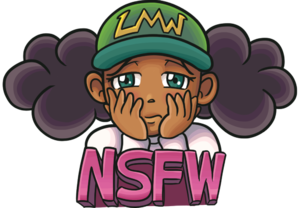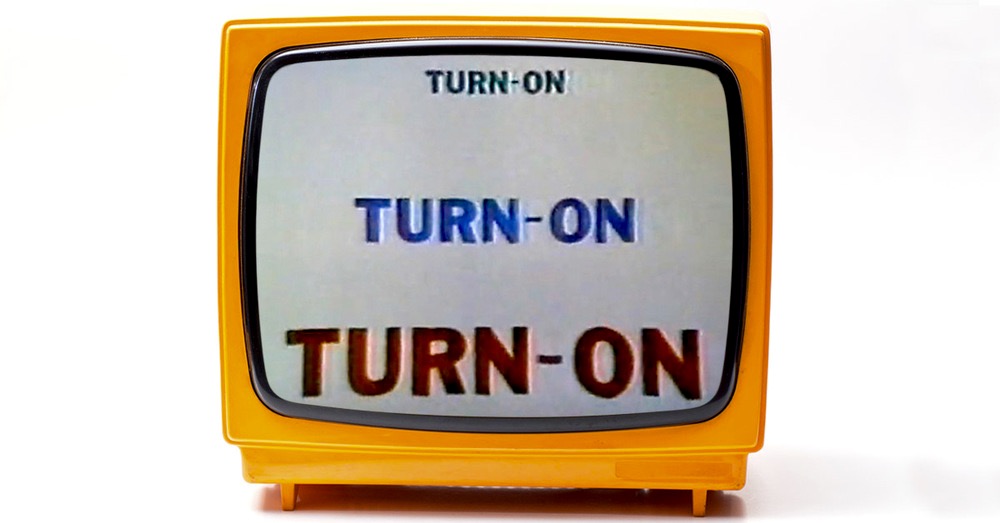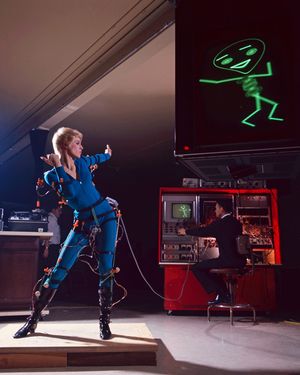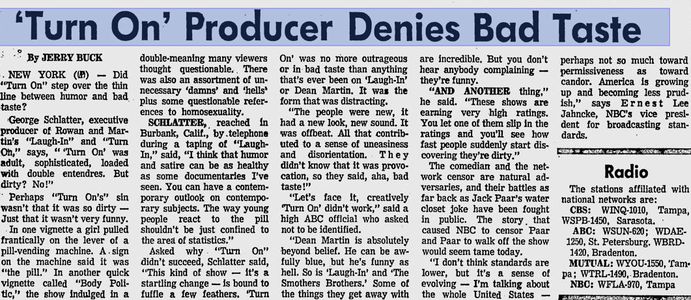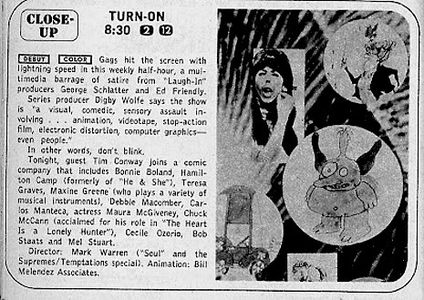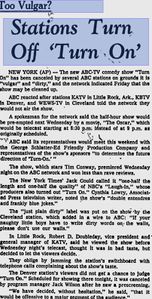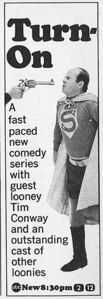Turn-On (found ABC sketch comedy series; 1969): Difference between revisions
Paulisdead (talk | contribs) m (→Modern Criticism: grammar) |
(Cleaning things up a bit. :)) |
||
| Line 6: | Line 6: | ||
|status=<span style="color:orange;">'''Partially Found'''</span> | |status=<span style="color:orange;">'''Partially Found'''</span> | ||
}} | }} | ||
On February 5th, 1969, ABC premiered | On February 5th, 1969, American TV network ABC premiered the sketch-comedy program '''''Turn-On'''''. Its first and only broadcast episode debuted at 8:30 pm ET. and rapidly also became the first and only TV series in history to be cancelled not just after but ''during'' its first episode, reortedly being yanked off the air by outraged affiliates even as it was still airing in Central US markets. Most West Coast viewers never saw it at all. The completed second episode along with any others in production were likewise never aired, '''and remain largely lost to this day.''' | ||
== | ==Production== | ||
''Turn-On'' was created by Ed Friendly & George Schlatter, producers of the iconic sketch comedy series ''Rowan & Martin's Laugh-In'', which had premiered the previous year to huge acclaim. As a result there was great interest in what the duo would come up with next... which was, as it turned out, the same daring, boundary-pushing sketch comedy taken to what they considered its natural next level. As exemplified by the new show's title, a pun on the counterculture slogan 'Tune in, turn on and drop out." | |||
Friendly and Schlatter envisioned a sketch comedy series that was so revolutionary it didn't even have a human host; sketches were supposedly 'programmed' via computer, which would also provide the Moog synthesizer-heavy soundtrack. The opening credits were intercut throughout the program, with no end credits. There were no permanent sets - all segments played out against an appropriately sterile white or black 'infinity' background - and no laugh track. The human cast included Teresa Graves, Hamilton Camp, Mel Stewart, Chuck McCann, and (eventually, at the behest of bewildered executives) a weekly guest host, which for the premiere was comedian Tim Conway. | |||
The cast included Teresa Graves, Hamilton Camp, Mel Stewart, Chuck McCann, | |||
Production executive Digby Wolfe described the as a "visual, comedic, sensory assault involving animation, videotape, stop-action film, electronic distortion, computer graphics—even people." This would also include the earliest form of motion capture technology. The short sketches (most no more than 7 seconds) were sexually suggestive, socially progressive and even vaguely blasphemous, all-but-guaranteeing the show would shock if not infuriate the average Middle American viewer. To add to the sense of disorientation the sketches played one after the other in quick cuts, appearing from different parts of the screen, often consisting solely of single surrealist one-liners - as in "President Nixon now becomes the ''tit''ular head of the Republican Party." The only named recurring character was E. Eddie Edwards, a shoe salesman with a foot fetish<ref>[https://podcasts.google.com/feed/aHR0cHM6Ly9mZWVkLnBvZGJlYW4uY29tL3BsdXN0d29jb21lZHkvZmVlZC54bWw/episode/cGx1c3R3b2NvbWVkeS5wb2RiZWFuLmNvbS9lcGlzb2RlLTM2LXR1cm4tb24tZjIwNzgyMjA4MmY4MWZlODkyODA2NmFiODk3ZmM0NDM?sa=X&ved=2ahUKEwjcibvpw9HxAhW0XDABHcV6Dq0QkfYCegQIARAF Stay Doomed - Episode 36 Turn-On]</ref> The premiere episode featured over 30 such avant-garde snippets in just 25 minutes - a dizzying pace even by today's standards, and by contemporary ones, as it turned out, nigh-unwatchable. | |||
[[File:02-turn-on.w570.h712.jpg|thumb|300px|Behind the scenes photo. A ''Turn-On'' dancer, seen using a primitive form of motion capture to render the stick figure on the monitor. The footage would later appear on YouTube. Photo: Yale Joel/The LIFE Picture Collection/Getty Images.]] | [[File:02-turn-on.w570.h712.jpg|thumb|300px|Behind the scenes photo. A ''Turn-On'' dancer, seen using a primitive form of motion capture to render the stick figure on the monitor. The footage would later appear on YouTube. Photo: Yale Joel/The LIFE Picture Collection/Getty Images.]] | ||
'' | Unsurprisingly eough, the pilot was summarily rejected by two of the three major American networks - not only ''Laugh-In'' parent NBC but CBS. home of much more conservative programming. An executive for the latter confessed, "It was so fast with the cuts and chops that some of our people actually got physically disturbed by it." Rival ABC, however, eager to ride the cutting-edge of this seemingly hot new comedy trend, approved the show for a projected 13-week run. Pharma company Bristol-Meyers was set to sponsor. | ||
According to Andrew Sandoval | According to an article in ''Vulture'', only two episodes had been produced as of the show's ignominious debut.<ref>[https://web.archive.org/web/20191113033757/https://www.vulture.com/2019/04/turn-on-sketch-comedy-tv-history.html Vulture - The ’60s Sketch-Comedy Show That Crashed and Burned Into TV Infamy By Charles Bramesco.] Retrieved 21 Jul '21</ref> However Andrew Sandoval, in ''The Monkees: The Day-By-Day Story of the 60s TV Pop Sensation'', claims that the band made an appearance in a different unaired episode, meaning that filming on a full series may at least have been in progress. | ||
==Premiere and Cancellation== | |||
ABC scheduled ''Turn-On'' to replace the successful (and, in its day, similarly daring) prime-time soap opera ''Peyton Place''. Whatever that audience might have been expecting, by all accounts they were resoundingly unimpressed by what they saw. As were frankly outraged affiliate station managers, who were happy to be quoted as such in the newspapers the next day. | |||
At WEWS-TV in Cleveland, the station whose objections are most often cited as the final straw leading to cancellation, a spokesman claimed that the station's switchboard was "lit up" with protest calls, and general manager Donald Perris derided ''Turn-On'' as being "in excessive poor taste." Upon summarily dropping the show at the second commercial break, Perris sent to ABC president Elton Rule an angry telegram: "If your naughty little boys have to write dirty words on the walls, please don't use our walls. ''Turn-On'' is turned off, as far as WEWS is concerned." | |||
Co-creator Schlatter would later claim that Perris actively lobbied other affiliates prior to the broadcast to force a network cancellation, but there is no independent verification of this. The market's other primary ABC affiliate, WAKR-TV in Akron, did not drop the program nor report receiving any complaints, but their general manager criticized the show's "questionable taste", and it swiftly became clear that many, many people across America agreed with him. ''Turn-On'' was at best much too far ahead of its time, and at worst, an artistic disaster on a scale that had never before been achieved on American television. | |||
Already formally cancelled, faced with near-total rejection from all sides, the creators decided to surrender in decisive fashion. Stations still broadcasting the show in the Central time zone abruptly cut to a card reading simply, "the remainder of this program will not be seen this evening, or ever." ABC then notified the Mountain and West Coast affiliates not to air the show at all, although it's unclear how many obeyed. In any event, by the next day, after a brief flurry of media coverage, the show had faded into television infamy. | |||
==Availability== | ==Availability== | ||
The | The ''Turn-On'' debacle was more-or-less forgotten until the 1980s, when ABC News aired a news report featuring footage from the show. In the course of which they revealed that the second episode had been completed, though not broadcast. A clip from this program was later uploaded to YouTube. | ||
While the two known episodes can be viewed at The Paley Center for Media in New York City, it is unknown if any other copies are available elsewhere | While the two known episodes can be viewed in full at The Paley Center for Media in New York City. However the episodes cannot be viewed outside of the Center, it is unknown if any other copies are available elsewhere. | ||
One other clip from the series is known to be available: one of the interstitial "dancing" animations. These interstitials were especially notable as some of the first uses of both computer graphics and motion capture in television history, and were produced using the ANIMAC video synthesizer. | One other clip from the series is known to be available: one of the interstitial "dancing" animations. These interstitials were especially notable as some of the first uses of both computer graphics and motion capture in television history, and were produced using the ANIMAC video synthesizer. The ''Turn-On'' clip can be found on ''Scanimate DVD-1'', a disc compilation generated by both ANIMAC along with its successors CAESAR and Scanimate. The DVD is sold online by Dave Sieg, engineering historian, and owner and caretaker of the last functional Scanimate unit.<ref>[http://www.scanimate.com/ Scanimate's official website, where the DVD is sold.] Retrieved 23 Aug '19</ref> On April 18, 2021 YouTube channel Ultimate History of CGI uploaded the clip under the title Turn On! Dancer (1969) - First dance motion capture. | ||
On March 1, 2021 another clip was uploaded to YouTube by user BlueFrog. The clip appeared to be from the first episode featuring a skit between an actress and guest host Tim Conway. | On March 1, 2021 another clip was uploaded to YouTube by user BlueFrog. The clip appeared to be from the first episode featuring a skit between an actress and guest host Tim Conway. | ||
==Modern | ==Modern critiques== | ||
''On the Plus Two Comedy'' series ''Stay Doomed'', hosts Laura Prince and Noah Houlihand visited the Paley Center | |||
''On the Plus Two Comedy'' series ''Stay Doomed'', hosts Laura Prince and Noah Houlihand visited the Paley Center for an episode about ''Turn-On''. Both found the presentation unnerving in much the same way that contemporary viewers had, pointing out that the avant-garde soundtrack combined with the fast edits, spilt screens, random messages and credits across the screen, all against the disorientating white background, made for uncomfortable viewing at best. They confirmed that in any case, screening such an experimental show in primetime 1969 was a mistake. | |||
While Prince gave the show a strongly negative review, Houlihand was more positive, giving it a "stay tuned" rating and adding that the show was like a "...Vine compilation video, if it was produced by Tim and Eric". Comparing the show's format to modern dark comedies like ''Too Many Cooks'', he noted that it would be at home on such modern surrealist showcases as Comedy Central's Adult Swim. | |||
==Gallery== | ==Gallery== | ||
Revision as of 23:27, 2 March 2023
On February 5th, 1969, American TV network ABC premiered the sketch-comedy program Turn-On. Its first and only broadcast episode debuted at 8:30 pm ET. and rapidly also became the first and only TV series in history to be cancelled not just after but during its first episode, reortedly being yanked off the air by outraged affiliates even as it was still airing in Central US markets. Most West Coast viewers never saw it at all. The completed second episode along with any others in production were likewise never aired, and remain largely lost to this day.
Production
Turn-On was created by Ed Friendly & George Schlatter, producers of the iconic sketch comedy series Rowan & Martin's Laugh-In, which had premiered the previous year to huge acclaim. As a result there was great interest in what the duo would come up with next... which was, as it turned out, the same daring, boundary-pushing sketch comedy taken to what they considered its natural next level. As exemplified by the new show's title, a pun on the counterculture slogan 'Tune in, turn on and drop out."
Friendly and Schlatter envisioned a sketch comedy series that was so revolutionary it didn't even have a human host; sketches were supposedly 'programmed' via computer, which would also provide the Moog synthesizer-heavy soundtrack. The opening credits were intercut throughout the program, with no end credits. There were no permanent sets - all segments played out against an appropriately sterile white or black 'infinity' background - and no laugh track. The human cast included Teresa Graves, Hamilton Camp, Mel Stewart, Chuck McCann, and (eventually, at the behest of bewildered executives) a weekly guest host, which for the premiere was comedian Tim Conway.
Production executive Digby Wolfe described the as a "visual, comedic, sensory assault involving animation, videotape, stop-action film, electronic distortion, computer graphics—even people." This would also include the earliest form of motion capture technology. The short sketches (most no more than 7 seconds) were sexually suggestive, socially progressive and even vaguely blasphemous, all-but-guaranteeing the show would shock if not infuriate the average Middle American viewer. To add to the sense of disorientation the sketches played one after the other in quick cuts, appearing from different parts of the screen, often consisting solely of single surrealist one-liners - as in "President Nixon now becomes the titular head of the Republican Party." The only named recurring character was E. Eddie Edwards, a shoe salesman with a foot fetish[1] The premiere episode featured over 30 such avant-garde snippets in just 25 minutes - a dizzying pace even by today's standards, and by contemporary ones, as it turned out, nigh-unwatchable.
Unsurprisingly eough, the pilot was summarily rejected by two of the three major American networks - not only Laugh-In parent NBC but CBS. home of much more conservative programming. An executive for the latter confessed, "It was so fast with the cuts and chops that some of our people actually got physically disturbed by it." Rival ABC, however, eager to ride the cutting-edge of this seemingly hot new comedy trend, approved the show for a projected 13-week run. Pharma company Bristol-Meyers was set to sponsor.
According to an article in Vulture, only two episodes had been produced as of the show's ignominious debut.[2] However Andrew Sandoval, in The Monkees: The Day-By-Day Story of the 60s TV Pop Sensation, claims that the band made an appearance in a different unaired episode, meaning that filming on a full series may at least have been in progress.
Premiere and Cancellation
ABC scheduled Turn-On to replace the successful (and, in its day, similarly daring) prime-time soap opera Peyton Place. Whatever that audience might have been expecting, by all accounts they were resoundingly unimpressed by what they saw. As were frankly outraged affiliate station managers, who were happy to be quoted as such in the newspapers the next day.
At WEWS-TV in Cleveland, the station whose objections are most often cited as the final straw leading to cancellation, a spokesman claimed that the station's switchboard was "lit up" with protest calls, and general manager Donald Perris derided Turn-On as being "in excessive poor taste." Upon summarily dropping the show at the second commercial break, Perris sent to ABC president Elton Rule an angry telegram: "If your naughty little boys have to write dirty words on the walls, please don't use our walls. Turn-On is turned off, as far as WEWS is concerned."
Co-creator Schlatter would later claim that Perris actively lobbied other affiliates prior to the broadcast to force a network cancellation, but there is no independent verification of this. The market's other primary ABC affiliate, WAKR-TV in Akron, did not drop the program nor report receiving any complaints, but their general manager criticized the show's "questionable taste", and it swiftly became clear that many, many people across America agreed with him. Turn-On was at best much too far ahead of its time, and at worst, an artistic disaster on a scale that had never before been achieved on American television.
Already formally cancelled, faced with near-total rejection from all sides, the creators decided to surrender in decisive fashion. Stations still broadcasting the show in the Central time zone abruptly cut to a card reading simply, "the remainder of this program will not be seen this evening, or ever." ABC then notified the Mountain and West Coast affiliates not to air the show at all, although it's unclear how many obeyed. In any event, by the next day, after a brief flurry of media coverage, the show had faded into television infamy.
Availability
The Turn-On debacle was more-or-less forgotten until the 1980s, when ABC News aired a news report featuring footage from the show. In the course of which they revealed that the second episode had been completed, though not broadcast. A clip from this program was later uploaded to YouTube.
While the two known episodes can be viewed in full at The Paley Center for Media in New York City. However the episodes cannot be viewed outside of the Center, it is unknown if any other copies are available elsewhere.
One other clip from the series is known to be available: one of the interstitial "dancing" animations. These interstitials were especially notable as some of the first uses of both computer graphics and motion capture in television history, and were produced using the ANIMAC video synthesizer. The Turn-On clip can be found on Scanimate DVD-1, a disc compilation generated by both ANIMAC along with its successors CAESAR and Scanimate. The DVD is sold online by Dave Sieg, engineering historian, and owner and caretaker of the last functional Scanimate unit.[3] On April 18, 2021 YouTube channel Ultimate History of CGI uploaded the clip under the title Turn On! Dancer (1969) - First dance motion capture.
On March 1, 2021 another clip was uploaded to YouTube by user BlueFrog. The clip appeared to be from the first episode featuring a skit between an actress and guest host Tim Conway.
Modern critiques
On the Plus Two Comedy series Stay Doomed, hosts Laura Prince and Noah Houlihand visited the Paley Center for an episode about Turn-On. Both found the presentation unnerving in much the same way that contemporary viewers had, pointing out that the avant-garde soundtrack combined with the fast edits, spilt screens, random messages and credits across the screen, all against the disorientating white background, made for uncomfortable viewing at best. They confirmed that in any case, screening such an experimental show in primetime 1969 was a mistake.
While Prince gave the show a strongly negative review, Houlihand was more positive, giving it a "stay tuned" rating and adding that the show was like a "...Vine compilation video, if it was produced by Tim and Eric". Comparing the show's format to modern dark comedies like Too Many Cooks, he noted that it would be at home on such modern surrealist showcases as Comedy Central's Adult Swim.
Gallery
Images
Videos
Reference
- ↑ Stay Doomed - Episode 36 Turn-On
- ↑ Vulture - The ’60s Sketch-Comedy Show That Crashed and Burned Into TV Infamy By Charles Bramesco. Retrieved 21 Jul '21
- ↑ Scanimate's official website, where the DVD is sold. Retrieved 23 Aug '19
